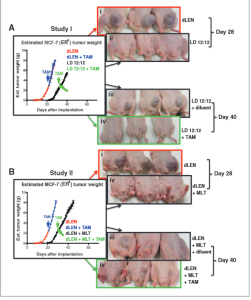Category: links
Red monochromatic light going through the eye pupil in the range of 610-760nm causes no pupillary constriction. Hitting eye pupil 7438K CCT white light with peak in blue 444nm causes a rapid contraction of the pupil.
Narrowing and broadening of the pupil is the job of ganglion cells. Besides other functions, their sensitivity is the strongest in the 460-480nm range. On monochromatic red light more than 600nm, ganglion cells do not respond as well as rhodopsin in rods.
July 2014 study
Robert T. Dauchy, Shulin Xiang, Lulu Mao, Samantha Brimer, Melissa A. Wren, Lin Yuan, Muralidharan Anbalagan, Adam Hauch, Tripp Frasch, Brian G. Rowan1, David E. Blask, and Steven M. Hill
Abstract
Resistance to endocrine therapy is a major impediment to successful treatment of breast cancer. Preclinical and
clinical evidence links resistance to antiestrogen drugs in breast cancer cells with the overexpression and/or
activation of various pro-oncogenic tyrosine kinases. Disruption of circadian rhythms by night shift work or
disturbed sleep-wake cycles may lead to an increased risk of breast cancer and other diseases. Moreover, light
exposure at night (LEN) suppresses the nocturnal production of melatonin that inhibits breast cancer growth. In
this study, we used a rat model of estrogen receptor (ERaþ) MCF-7 tumor xenografts to demonstrate how altering
light/dark cycles with dim LEN (dLEN) speed the development of breast tumors, increasing their metabolism and
growth and conferring an intrinsic resistance to tamoxifen therapy. These characteristics were not observed in
animals in which the circadian melatonin rhythm was not disrupted, or in animals subjected to dLEN if they
received nocturnal melatonin replacement. Strikingly, our results also showed that melatonin acted both as a tumor
metabolic inhibitor and a circadian-regulated kinase inhibitor to reestablish the sensitivity of breast tumors to
tamoxifen and tumor regression. Together, our findings show how dLEN-mediated disturbances in nocturnal
melatonin production can render tumors insensitive to tamoxifen. Cancer Res; 74(15); 1–12. 2014 AACR.
picture:
Differential effects of 4OH-TAM on the growth and regression of (ERaþ ) MCF-7 tissue-isolated breast tumor xenografts in female nude rats housed in standard lighting schedule (LD 12:12) or in dLEN lighting schedules with or without melatonin supplementation. A, study I, estimated tumor weight (g/d) of MCF-7 (ERaþ) human breast tumor xenografts from nude rats exposed to a dLEN lighting schedule and treated diluent (red triangles) with 4OH-TAM (blue triangles; 80 mg/kg/d) or a LD 12:12 lighting schedule and treated with diluent (black circles) or 4OH-TAM (green circles). B, study II, estimated tumor weight (g/d) of MCF-7 (ERaþ) human breast tumor xenografts from nude rats exposed to a dLEN lighting schedule and treated with vehicle (red triangles) or 4OH-TAM (blue triangles; 80 mg/kg/d) or in a dLEN lighting schedule supplemented with exogenous melatonin at night and treated vehicle (black circles) or 4OH-TAM (green circles). Tumor weights were estimated daily as described in Materials and Methods. Images of tumor-bearing nude rats in studies I (A, i–iv) and II (B, i–iv) maintained on either experimental (dLEN) or control (LD12:12) lighting schedules, as described in Materials and Methods. A, xengografts from experimental animals 28 days after tumor implant in dLEN (i, top) and LD 12:12 (ii). iii and iv, xenografts from experimental animals 40 days after tumor implant in LD 12:12 and diluent treatment (iii) and LD 12:12 after 28 days of treatment with tamoxifen (iv). Photographs in B are xenografts from experimental animals 28 days after tumor implant in control dLEN lighting schedule (i) and dLEN supplemented with exogenous nighttime melatonin (ii). B, iii, xenografts from experimental animals 40 days after tumor implant in dLEN supplemented with exogenous nighttime melatonin and administered the vehicle for tamoxifen. B, iv, xenografts from experimental animals 40 days after tumor implant in dLEN but supplemented with exogenous nighttime melatonin and after treatment with tamoxifen.
Whole study can be read here.
